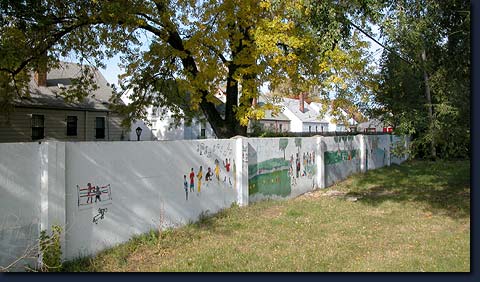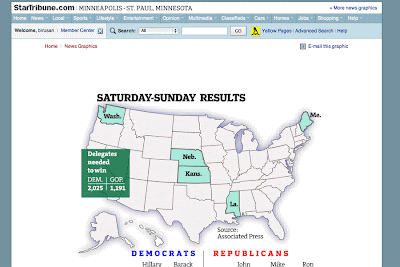
Once upon a time there was a University. It lived on the banks of a middle-sized river, along a middle-sized valley, in a middle-sized city in the Middle West. One day it decided to grow. It would build a bridge across the river.
"It would be a magnificent bridge," thought the University, "a bridge to the 21st century, spanning time, bridging the past and the future." "It would be a bridge," thought the University, "for the future top three public research University in the World!" And it lived happily ever after.
Well, I've long thought that the
Washington Avenue Bridge (WAB) was an unusual space, a bridge of mystery and paradox housing endless riddles. And I've thought for some time that this bridge holds within its double-decked beams all the history of 20th century urban planning. And, as such, its a bridge where
dreams go to die.
Because it has something for everybody. It's a fine experience, crossing the WAB on a lovely winter's morning. You can bicycle in the long bike lane, looking off to your left at the twisted steel beams forming a bridge graveyard on the flat land that once housed a large fraction of Minneapolis's bohemian culture. You zip along in your very own lane, through the cool air high over the Mississippi.

[The view of the WAB from the Gehry-inspired pre-WAB bridge, that connects the green grass of the mall to the student union.] Or, you can take a five-minute walk on the other side, a 'pedestrian only' land lit by lines of round lamps. Feel free to pause and gaze on the broad river valley twisting away downstream toward Fort Snelling, your cold hands on the endless metal railing that stretches to a vanishing point, shakes with the sounds of a truck, with faintly felt vibrations of traffic passing just beneath your feet.

On the coldest days opt for the middle passage, a long and endless tunnel filled with empty benches, concrete lit by grated, aging lights, sitting under heaters that don't work. But it's probably my favorite space on campus. Each panel is painted with a different group and the University. They're refreshed and repainted every year, and every time you walk across the bridge you're surprised by a new student group you never imagined might exist. (E.g. The Christopher Walken Appreciation Society!) [
h/t MN Daily link]
And all the while, underfoot, four lanes of traffic whiz by at fifty miles an hour, streaming unimpeded from the interstate or downtown.
If pressed, I'd say that the WAB is the third most thoroughly modern part of the Twin Cities, falling somewhere on the down side of the M. O. A. and the Metrodome, and right before the Skyway system. It's a modernist fantasy straight out of Italian futurism, Fritz Lang's Metropolis, or Le Corbousier's sketches . . . pedestrians and cars, each getting their separate spaces, neatly severed and stacked, each living in peace at their own paces. It's the dream of speed.
 [The rather sterile pedestrian wonderland that is the top deck of the WAB.]
[The rather sterile pedestrian wonderland that is the top deck of the WAB.]That said, the WAB seems like a failure today. Sure, its probably the most democratic space on a campus filled with students . . . anyone can paint a panel, anyone can hand out fliers. On the WAB, I've seen political canvassers, hunger strikers, and even trenchcoat-clad middle-aged men with combovers passing out little green Gideons' New Testaments to anyone who would take one.

[The ground at the West Bank hangs over the street like an apocalypse, lifting the thousands of students away from the banks of the Mississippi.]
But every day that I get off the bus to the West Bank and walk all the way down the sidewalk, around a staircase railing that takes you fifty feet out of your way, up the stairs and through the two sets of double doors into the basement of Wiley Hall, down to the left, around the blank hallway to the right, down the thirty foot corridor, to the left and up the two flights of poured concrete stairs, around the corner to the left, and through the doors out into the clear blue West Bank sky, I wonder how the hell this long and twisted labyrinth is the only way to get from the bus to the Campus's main street. This may sound like a petty complaint, but the WAB's neatly modern separation of uses makes any sort of modal reintegration paradoxical.
To take the other example, try waiting for the Eastbound bus on the West Bank. Here, you stand in a windswept concrete hell next to a freeway, cars whizzing past you every four seconds, lit by sodium lamps that flicker in and out like clockwork. The building behind you seems abandoned, and the bleak grey tones of the dirty concrete belie the fact that you're perched next to a riverbank filled with nature. Here you are, in a city where wild topography is at a steep premium, you happen to be a hundred feet from a beautiful bluff, and all you can see is the inside of an interstate. Hordes of students wait for buses huddled like hobos, or hunkered like hobbits in the eternal darkness of Interstate Mordor.
 [Somewhere out there, birds are singing, the sun is shining, and it's a beautiful day.]
[Somewhere out there, birds are singing, the sun is shining, and it's a beautiful day.]At this point, I'm sure you're thinking: Why is this important?
It's important because all this is going to change. Finally, after almost thirty years of planning, the Central Corridor Light Rail line is going to run thorugh the U of MN campus, and tomorrow the Metro Council is going to vote to close off Washington Avenue to passenger cars, and turn all this space under the bridge into a pedestrian-and-transit mall (like Nicollet Avenue downtown).

Washington Avenue, instead of running through the main campus mall like a knife through whipped cream, separating the student union from fields of green green grass like a Belfast "
Peace Wall", running its four lanes of unceasing traffic through the heart of campus like an ice skate at a sandal convention . . . instead, this space may one day become a pleasant plaza, a place where students gather, cavort, play frisbee, and hit on each other. One day soon, this campus may have some life in it!
It's always boggled my mind that the U of MN campus feels so lifeless. Here we have close to fifty thousand twenty year-olds in large groups getting drunk, and barring the occasional hockey riot, nobody ever seems to be having very much fun. There's little in the way of street life, public merriment, or public fraternal idiocy. Sometimes the place feels like downtown Saint Paul on a weekend, and I'm convinced that one of the reasons for this hormonal dearth is the detrimental effect of the WAB.
In fact, the problem with modernism has always been its inflexibility, by which I mean that the two sides of the WAB are completely incompatible. By which I mean, you either have modernism, or you don't . . . that there's no in between. On one end, you have high-speed car traffic neatly separated from pedestrians and people, and an actually four-lane freeway flowing into the very center of a packed and crowded campus. On the other end you find the main University mall, the grassy bits between Northrop and Cauffman, and what passes for street life at 'the U'. And eventually, these two transportation regimes must meet. Whose idea was it to have thousands of cars drive at 40 mph into crowds of pedestrians? Can freeways and sidewalks coexist? Cars come streaming out of the freeway bridge, and run smack dab into the 20 mph, pedestrian-friendly stadium village. I'm surprised more people aren't horribly maimed!
The Star Tribune had
an article today about the Met Council's impending decision on the Light Rail route, which will serve as a compromise between the various constituencies along the corridor (The Saint Paul Chamber of Commerce, the U of MN, and residential neighborhood groups). It's going to bring the train right up to the front of the renovated Union Depot train station, cutting kitty-corner through one of the blocks downtown. It's going to include some room to one day expand with stops every half mile along University Avenue, while keeping them a mile apart for the time being. And, most importantly, its going to run at grade along the University of Minnesota campus, instead of tunneling underneath the school like a real subway.
And while the U of MN administration
lobbied heavily for the tunnel option, Vice-Provost Kathleen O'Brien even going so far as to claim that trains would endanger pedestrians (as if the thousands of cars moving at them every day pose a lesser threat), I think the "compromise" option is actually far better than a tunnel would have been. This way, the campus can maybe start to rethink the relationship between automobiles and people.

[Once upon a time, there was a giant snow-gopher, who lived in a long dark tunnel on a long dark bridge over a long dark river in a long dark town . . .]
UPDATE:
This is what Larry Millett's AIA Guide to the Twin Cities has to say about the WAB:The only double-decker bridge in the Twin Cities, with pedestrian on the upper level and vehicles below. Intended to provide a strong link between the university's East and West Bank campuses, the bridge is utterly prosaic. As built, it was also impractical: the pedestrian deck was left open to the elements. A clumsy enclosure was added later; if anything it made the bridge look worse. Over the years, the bridge has been the unfortunate site of several suicides, including that of poet John Berryman, a university professor who jumped to his death in 1972.
 A lot has gone down since we last checked in with Pothole Pawlenty, and it looks like some potholes might be filled. (So long, potholes!)
A lot has gone down since we last checked in with Pothole Pawlenty, and it looks like some potholes might be filled. (So long, potholes!)






























